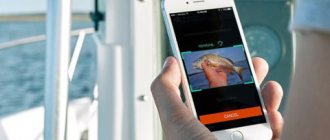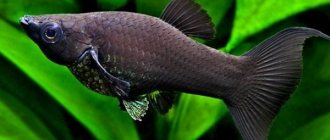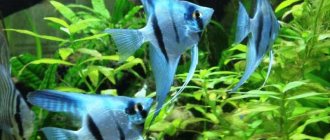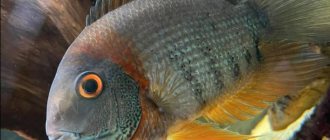Carp rubella is considered a rather dangerous and highly contagious fish disease. It, like other bacterial diseases of salmon, can cause enormous damage to fisheries. It is widespread in Western Europe, as well as southern Russia. Most often suffer from this disease.
- Carps;
- carp;
- crucian carp and some herbivorous species.
So far, it has not been possible to find the exact cause of this disease. Aeromonas punctata is considered the likely causative agent. It is a short, mobile rod and a facultative anaerobe. It was noticed in the intestines and tissues of both sick individuals and healthy ones, so this hypothesis is vulnerable. Rubella occurs and progresses as a result of exposure to a number of different factors, among which water temperature is of particular importance. Most often, an outbreak of rubella occurs in the spring, when the water temperature is just beginning to rise and the pH decreases.
Manifestations of rubella
Sick individuals suffer from a malfunction of the excretory system, so exudate accumulates in different parts of their bodies. Due to the fact that the abdomen is filled with fluid, the fish begins to develop dropsy. When liquid collects under the scale pockets, the scale itself begins to ripple and red spots appear on its surface. The disease is quite acute and, most often, its result is mass death of fish.
It occurs mainly in the summer, dying out closer to autumn, as soon as the temperature begins to drop. The carp mortality rate can reach 30%.
How to get rid of rubella fish?
To get a positive result from therapy, it is important to promptly begin treatment measures when the first signs first appear.
If rubella is caused by viruses, the disease is called viremia.
In addition to timely assistance, special medications should be used to safely get rid of the disease. They contain a substance that is active against aeromonosis bacteria. To prevent the appearance of rubella, it is necessary to use proven and effective remedies.
The following drugs have earned a good reputation among the variety of existing drugs:
1. Methylene blue; 2. Biovit-80; 3. Furazolidone.
These products have excellent recommendations, their effectiveness and high reliability have been proven. This is evidenced by information received from fish farms and owners of ornamental fish.
The data provided indicate that the use of the above drugs in the early stages of the disease is justified. They bring tangible benefits to fish, therefore, their use is useful.
It has long been known that it is much easier to prevent any illness in time than to get rid of it later. Rubella is no exception. A good prevention of aeromonosis is to keep the aquarium or pond in which the fish live clean. If you follow simple rules, as well as basic hygiene standards, the risk of illness will decrease several times.
After all, then the rubella pathogens will not be able to multiply enough to cause massive infection of fish.
When the disease has already been identified, immediate removal of sick individuals is required, draining the aquarium or pond, and then treating it with disinfectants.
The fish should be placed in clean water to which a certain amount of Methylene blue has been added.
This drug is also actively used during fish transportation. To do this, it is poured into water so that the liquid acquires a dark blue color. A pale shade indicates insufficient concentration. To achieve the maximum effect of therapy, you should saturate the water with oxygen. The use of aeration will facilitate successful treatment. Such measures are suitable for both fish in a pond and aquarium specimens.
Since getting rid of aeromonosis must be complex, antimicrobial agents should also be used internally. It is necessary to add Furazolidone and Biovit-80 to the food of sick fish.
Methylene blue is also used, which should be present not only in the water itself, but also in food.
Norms for the use of drugs:
1. 1 kilogram of Methylene blue is mixed with a ton of feed. The drug should be given every other day, taking three-day breaks after each week. The course of treatment lasts 21 days.
2. 400-600 grams of furazolidone are added to 1000 kilograms of feed. The mixture is used for 5 days, after two days the treatment is repeated again.
3. 13 kilograms of Biovita-80 are mixed with a ton of feed. It is given to affected individuals for 5 days in a row with an interruption of 2 days. Treatment of rubella with such drugs is not only highly effective, but also low in cost. For the fish owner, using them is beneficial and easy on the wallet. You can purchase Furazolidone or Biovit-80 at a very affordable price. Therefore, the owner will not lose the bulk of the profit, having the opportunity to sell the recovered fish.
The costs of getting rid of aeromonosis will not be too high, which means they will not affect the financial situation of the owner. Surely, this information will please many, because it is always nice to find an effective and at the same time cheap therapeutic agent.
If we talk about viremia (viral rubella in fish), it is important to know that fish farm owners and professional veterinarians advise using probiotics for preventive purposes, as well as for the treatment of sick individuals. If therapeutic measures are started late, causing complications, then it is necessary to adhere to the same treatment rules as for a bacterial infection.
To find out more information about the prevention, disposal of aeromonosis and viremia, you should consult with veterinary specialists. They will provide comprehensive information about the methods and methods of therapy, guided by their professionalism and experience.
Diagnosis of rubella
The disease is popular among different age groups of fish. Its incubation period lasts 3 weeks, but may vary depending on the general temperature. During the incubation period, the disease cannot be detected, even if it has managed to penetrate the individual’s body. Fish suffering from an acute form of the disease and having damaged organs may have a healthy appearance.
To detect the disease, you need to open several individuals to examine their internal organs. It is necessary to catch weak fish with sunken eyes. Sick individuals eat poorly or cannot eat normally at all.
Plague of fish
In the fall, fishermen are surprised when the snout of a caught pike turns bright red, as if painted with lipstick. There are also hemorrhages on the pectoral fins, and sickle-shaped wounds appear throughout the body. This disease was first registered in Germany at the beginning of the last century. After the war, young pike were massively imported from there for breeding - and so the plague was introduced into the waters of Russia.
Plague on pike Plague
Now pike, catfish, burbot, perch, bream and roach are suffering from the plague throughout the central region, in the middle zone, as well as in the reservoirs of Northern Kazakhstan. The disease is not dangerous for humans, but eating such fish can cause food poisoning, since the meat is saturated with decay products.
Fibrosarcoma
In principle, this is also not a disease of fish that is dangerous to humans, most often of very large fish - pike perch and pike, cyprinids, less often - marinka and asp. Sick fish are more often found in the fall; small and very large tumors are noticeable on its body. They can be white, light gray, brown, pink, and ulcers are often visible next to them. Such fish suffer from an increased appetite and grab everything that moves, so they are most often caught with live bait and lures. Eating such fish is strictly not recommended.
Fibrosarcoma of crucian carp
There have been recorded cases of food poisoning with a difficult recovery period and subsequent cancer (not necessarily for this reason), since the nature of this disease is viral, and it is not yet clear how these viruses interact with human cells.
Diphyllobothriasis
Diphyllobothriasis is a helminthic disease affecting the digestive organs. The causative agent is the broad tapeworm. This is the largest of the human helminths, its length can reach 10 and sometimes 20 meters. The parasite consists of a head, neck and body. The head is oblong oval in shape, flattened on the sides and has on its narrow sides two longitudinal suction slits (bothria), with which the tapeworm is attached to the intestinal wall. The body consists of many segments, and the width is much greater than the length, which is due to the name of the parasite (wide tapeworm). The number of segments can reach 3000-4000 pieces. The tapeworm lives in the upper parts of the small intestines, feeds on the entire surface of the body, while absorbing various nutrients, including vitamins Bi2 and folic acid. The wide tapeworm is hermaphrodite. During the day, up to 2 million eggs are released into the external environment with feces. The number of parasites can reach up to 100 copies. The lifespan of parasites in the human body reaches 28 years.
For the development of a wide tapeworm, like opisthorchiasis, the presence of three hosts is necessary.
The definitive host is humans, domestic and wild animals. All of them secrete eggs, which end up in water bodies with meltwater. Diphyllobothriasis cannot be contracted through water.
The intermediate host is Cyclops (crustaceans). The eggs are swallowed by crustaceans (cyclops) and larvae develop in their bodies. Cyclops are swallowed as food by freshwater predatory fish.
Additional hosts are fish of predatory species: pike, burbot, perch, ruff; pike caviar is especially dangerous.
Having attached themselves to the wall of the intestines, the parasites injure the intestinal mucosa with bothria and can be one of the reasons for its necrosis. Sometimes intestinal blockage occurs.
Diphyllobothriasis occurs in mild or severe form, which is associated with the intensity of invasion, the presence of concomitant diseases and the general condition of the body. Sometimes the disease is asymptomatic.
In mild cases, patients complain of general weakness, poor appetite, nausea, pain and rumbling in the abdomen, intestinal disorders, and decreased ability to work.
In severe cases, intestinal obstruction occurs. In 2-3% of patients, a severe form of anemia (anemia) occurs. Patients complain of weakness, drowsiness, dizziness. Bright red spots and cracks appear on the tongue. The skin becomes pale with a yellowish tint; The liver and spleen may enlarge. Body temperature reaches 36-38 degrees.
The diagnosis of these diseases is established based on the detection of tapeworm and opisthorchid eggs in the feces.
Forms of the disease
Depending on the predominance of certain clinical manifestations, the following forms of aeromonosis exist.
Ascites.
It is observed in acute cases and is characterized by deep dermatitis, which is accompanied by swelling of muscle and fatty tissue; dropsy of the whole body and accumulation of fluid in the abdominal cavity, adhesive inflammation of internal organs, peritonitis, hemorrhages in the mucous membranes of the intestines, heart tissue.
Ulcerative.
Observed in chronic conditions. Ulcers form on the body of the fish, shaped like a crater, with a gray-red bottom and red edges. In such lesions, scale loss may occur. As the individual recovers, scars form in these areas. Sick fish may have a pronounced curvature of the spine, as well as deforming lesions of the bones of the head and fins.
Ascitic-ulcerative.
With this form of aeromonosis, a combination of ascites and ulcerative skin lesions is observed.
Lerneosis
All types of fish, and most often carp, silver carp and pike, in mid-summer are affected by the parasitic crustacean that causes this disease. It is also called an anchor worm. Abscesses appear on the fish body in the form of tubercles, in the center of which a hard rod about 1 cm long, green-brown in color, is gradually visible. If you pull it out, 4 transparent horns will be visible at the tip. This is the same crustacean that gradually penetrates the fish’s body.
Lerneosis crustacean Lernea Lerneosis on catfish
Crayfish are not dangerous for humans, but it is unlikely that anyone would want to eat such fish. It must be disposed of away from the water, buried or burned, otherwise birds and rats will return the parasite back to the water.
Piscicolosis
Most often, sick fish are caught in the fall, when the parasites - piscicola leeches - grow to visible sizes. They settle in the area of the head and tail, look like a spindle, the whole body is covered with white and dark gray or brown stripes. Sick fish feel severe itching, they are very restless, jump out of the water, and are not afraid of anything. After the leech falls off, bleeding wounds remain on the body, on which fungi settle, causing another dangerous fish disease for humans - saprolegniosis. It is strictly not recommended to eat fish on which piscicolae are found, since leeches inject a special substance into the blood that prevents it from clotting. If you eat a lot of such fish, you can get severe poisoning with impaired kidney and liver function. Infected fish should be destroyed in any way, it is better to do this as far as possible from bodies of water.
Piscicola on a fish Piscicola close-up Piscicola leech
Prevention
Rubella can be prevented with a vaccine. This vaccination is included in the calendars of all countries and is critical to curb the spread of the disease and prevent birth defects in the fetus caused by congenital rubella syndrome.
The first dose of the vaccine is usually given to children at 12 months of age as part of routine immunization against measles, mumps and rubella. The second dose is usually given at age 6 years. It is acceptable to give a second dose of the vaccine 6 months after the first, or even 1 month later if we know the child is at increased risk of contracting the disease.
Rubella vaccine should not be given to pregnant women or women who plan to become pregnant within 1 month of vaccination. If you are thinking about pregnancy, make sure you are immune to rubella by getting a blood test or looking for documentation of any vaccines you have received (you must have two doses of the vaccine). If there is no immunity, you should get vaccinated at least 1 month before pregnancy.
Are fish diseases dangerous for humans?
Diseases of carp fish can be dangerous to people. In addition to known helminthiases, fish can sometimes cause toxic infections in humans.
The main sources of the spread of the disease are uncontrolled transportation from not entirely prosperous farms to good ones. Other diseases are focal in nature. This suggests that in some regions of the country wild fish are carriers of foci of infection, living in natural reservoirs. It is almost impossible to make your farm healthy in such an area, because transportation from such a region to a healthy body of water will lead to contamination. Veterinary certificates, unfortunately, do not always reflect reality. In general, cases of diseased fish being brought into healthy bodies of water have become more frequent, which may well lead to the collapse of the entire economy. This is very dangerous for those structures that organize fishing trips.
Since there are carp diseases that are dangerous to humans, you need to be careful when choosing fish.
Trienophorosis
The causative agent of the disease is a cestode from the genus Triaenophorus. Development occurs with the participation of two intermediate hosts: crustaceans and fish, mainly trout, perch, and a number of cyprinids. The main host is pike. If there are both trout and pike in the reservoir, the occurrence of this disease becomes very likely. The management of fish farms where fishing is organized and where trout are imported needs to implement a set of measures to prevent this disease. Treatment for the disease has not been developed. In order to prevent fish diseases in pond farms, it is necessary to protect the ponds from the penetration of pike into them from water supply sources.
With intensive infection, emaciation of fish, bloating of the abdomen, and pallor of the mucous membranes are observed. Deaths have been observed among fry and young of the year.
Symptoms
The illness usually begins with one to two days of mild fever (up to 38°C) and swollen, tender lymph nodes, usually in the back of the neck or behind the ears. A pale pink, blotchy rash then appears on the face and spreads downward. As it spreads to the lower parts of the body, the face is usually already cleared.
A rubella rash is often the first sign of illness that a parent notices. It may look like many other viral rashes, appearing as pink or light red spots that may coalesce to form patches of even color. The rash may be itchy and lasts up to 3 days. When the rash disappears, fine-plate peeling may remain in its place.
Other symptoms of rubella (more common in teenagers and adults) may include headache, loss of appetite, mild conjunctivitis (inflammation of the lining of the eyelids and eyeballs), nasal congestion or discharge, and swollen lymph nodes in other parts of the body.
If a pregnant woman contracts rubella, she may develop congenital rubella syndrome, which can have devastating consequences for the developing fetus. Children infected with rubella before birth are at risk of impaired growth, intellectual defects, heart and eye defects, deafness, and problems with the liver, spleen, and bone marrow.
The rubella rash usually lasts 3 days. Lymph nodes may remain swollen for a week or more, and joint pain may last over 2 weeks. Children with rubella usually recover within 1 week, but adults may take longer.
Contagiousness
The rubella virus is spread from person to person through tiny droplets of fluid from the nose and throat when sneezing and coughing. People with rubella are most contagious 1 week or more before the rash appears and up to 1 week after it appears. Someone who is infected but has no symptoms can also spread the virus.
Infants with congenital rubella syndrome can shed the virus in their urine and nasal mucus for a year or more, which means they can infect unvaccinated people.
Argulosis
If in a pond overgrown with reeds, cattails, pondweed, reeds, water buckwheat, and elodea, you catch a fish (usually perch and cyprinids) with small (5–10 mm) moving crustaceans visible on its body, then this is another common parasitic disease. The crustacean looks like a speck with a proboscis, with which it pierces even hard scales and feeds on the blood of the victim. The crustaceans are greenish in color and very active. They float freely in water and are easily transferred from pond to pond. At the site of damage, small wounds, about 1 mm in diameter, form, which quickly become infected with fungi, the same saprolegnia.
Argulosis on fish Argulosis crustaceans











